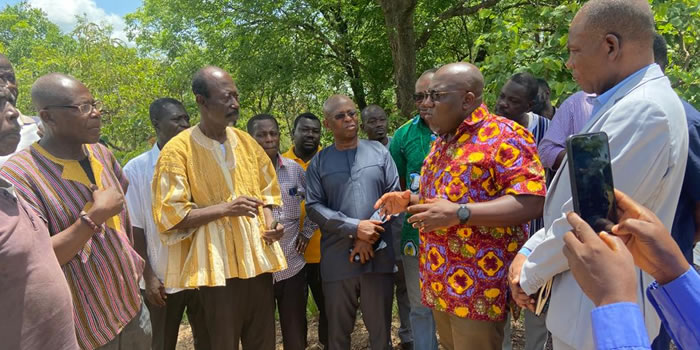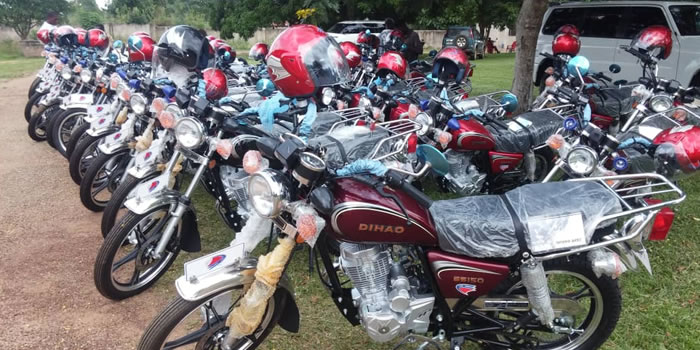

Social Characteristics
Introduction
Household structure plays an important role in the economic and social well-being of families and individuals. This is because the number and characteristics of household members affect the types of relationships and the pool of economic resources available within the household (Jacobsen, 2012)
The 2010 PHC defines a household as a person or a group of persons, who lived together in the same house or compound and share the same house-keeping arrangements and constitute a single consumption unit.
Household members are not necessarily related by blood or marriage because friends and hired domestic workers may also be part of households. The information on households basically includes household structure, composition, and relationship to head of household (2010 PHC National Analytical Report)
This chapter gives an overview of the demographic characteristics of the Kwahu Afram Plains North District such as socio-demographic variables, which include: household size, composition and headship, marital status, nationality, religious affiliation, literacy and education.
Household size, Structure and composition
Table 3.1 indicates that there are 20,062 households in the Kwahu Afram Plains North district with nearly ninety percent (89.7%) in the rural areas compared with just a little over ten percent(10.2%) in the urban areas.
The average household per house for the district according to the 2010 census is 1.0 with the urban areas recording a greater number than the rural areas implying that there are more persons in a house in urban settings than in the rural areas.
The average household size for the district is 4.9 comparing with 4 for the region as a whole and interestingly it is one of the highest in the region.
Household Composition
Household composition is determined by the people living together and their relationships to one another.
This includes relationships such as spouse (wife/husband), child (son/daughter), grandchild, parent/parent-in-law, brother/sister, other relative and non-relative.
In all the total number of households in the district are 20,943 with an average size of 5 persons per household.
The households in the District are predominantly male- headed 75.4 percent with the percentage of female headed as (24.6%). Nuclear family which constitutes the head, 24
spouse(s) and children household type recorded the highest percentage (38.1%) in the District.
Table 3.2 presents data on household by composition and sex in Afram Plains North District. Children form the majority of household members recording 48.3percent of all household composition.
Male children (sons) who are staying with their parents recorded the highest percentage (50%) while son/daughter in-law and adopted/foster child recorded the least percentages of less than one percent (0.5% and 0.6%) respectively.
Grand children are the third highest 11.8 percent of the composition of household members. The higher percentages recorded for children and grandchildren, could be the result of teenage pregnancy, cohabitation, children born outside marriage due to the influx of migrants into the District.
Most children born in the District by teenage parents are abandoned to their grandparents to take care of them since their parents do not have the capacity to cater for their children.
Information Communication Technology
Introduction
Information Communication Technology (ICT) has become an integral part of the Ghanaian economy. During the 2010 PHC, ownership and usage of information communication technology facilities and services were assessed by collecting data on both individuals/persons aged 12 years and older in households.
Persons using internet facility refers to those who have access to internet facility at home, internet café, and mobile phone or by other mobile device. Internet access is assumed to be not only via computer but also by mobile phone, game machine and digital televisions (Eastern 2010 PHC Report)
This chapter analyzes information and communication technology accessibility by socio-demographic characteristics such as sex, ownership of mobile phones, the use of internet, household ownership of fixed telephone lines, desktop or laptops in Kwahu Afram Plains North District.
Ownership of Mobile Phones
Analysis of the ownership of mobile phones in Kwahu Afram Plains North District is shown in Table 5.1. The table indicates that 22.9 percent of the total persons aged 12 years and older who were enumerated have mobile phones in the district. While 27.5 percent of males have mobile phones 17.8 percent of females have mobile phones.
Use of Internet
Kwahu Afram Plains North District in the period of the 2010 Population and Housing Census recorded 2.1 percent of the total population 12 years and older using internet facility. One of the factors that led to the low percentage of the use of internet facility is as the result of poor accessibility of internet facility in the district. On the sexes, 2.7 percent of males as compared to 1.4 percent of females use internet facilities.
Household Ownership of Desktop or Laptop Computer
The usefulness of desktop and laptop computers in this modern world cannot be over emphasized. Variations in usage of the devise among countries, regions and demographic groups seem significant. This is especially true of those who are young adults, have higher levels of education, and who live in households that have relatively high annual income.
The divide between male-headed households and female-headed household having desktop/laptop is very significant. Male-headed households constitute 2.8 percent of the total households having desktop / laptop computers while 1.7 percent of female-headed households have this device.
Housing Conditions
Introduction
This chapter presents information about housing characteristics in the Kwahu Afram Plains North District. These include housing stock, type of materials used for dwelling unit, number of sleeping rooms occupied by household members, ownership of houses, fuel for cooking and nature of waste disposal (solid and liquid).
Housing Stock
Table 8.1 presents the stock of houses and households by type of locality. The district households population (100,568) live in a total of 20,062 houses. The average household size of the district is 4.9 persons, higher than the national (4.5) and regional (4.2) averages. The average household size in the urban and rural areas is 4.0 and 5.1 persons respectively
The average population per house in the district stands at 5.1 persons, lower than the regional average of 6.1 persons. The district has the same average households per house (1.0) as the district and rural areas. However, the urban average household per house is 1.8.
Type of Dwelling, Holding and Tenancy Arrangements
Ownership status of dwelling
Table 8.2 shows that a substantial proportion (78.3%) of households live in dwelling units owned by a member of the household. Ownership of dwelling by a relative other than household member is 7.3 percent while that of other private individual and other private agency each accounts for10.8 and 0.5 percent respectively.
In the district, the proportion of female headed household ownership of dwelling is lower (71.7%) than the male headed ownership of dwelling (80.4%).
With reference to ownership of dwelling by relative other than household member, female headed households account for 11.8 percent while the male headed households account for only 5.8 percent. Likewise, other private individual female headed household account for only 13.2 percent of dwelling units.
Percentage Ownership Status of dwelling households
In the urban areas, ownership by household member accounts for 48.9 percent compared to 84.3 percent in the rural areas. 51
Ownership of dwelling in urban areas by relative rather than a household member and other private individual accounts for 8.1% and 32.4 percent respectively compared to 7.1% and 6.3 percent respectively in rural areas.
Percentage Ownership Status of dwelling households
In the urban areas, ownership by household member accounts for 48.9 percent compared to 84.3 percent in the rural areas. 51
Ownership of dwelling in urban areas by relative rather than a household member and other private individual accounts for 8.1% and 32.4 percent respectively compared to 7.1% and 6.3 percent respectively in rural areas.
The availability, accessibility and affordability of kerosene and kerosene lamp are necessary for lighting purposes in the district and should therefore engage the attention of planners and the local administration.
In addition, the rural electrification programme needs to be intensified as the availability of electricity is not meant only for household lighting and cooking but also for the promotion of industrial and other economic activities, including preservation of food.
Date Created : 11/26/2017 1:05:29 AM













 facebook
facebook
 twitter
twitter
 Youtube
Youtube
 +233 593 831 280
+233 593 831 280 0800 430 430
0800 430 430 GPS: GE-231-4383
GPS: GE-231-4383 info@ghanadistricts.com
info@ghanadistricts.com Box GP1044, Accra, Ghana
Box GP1044, Accra, Ghana